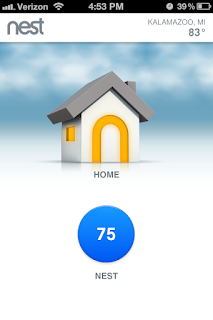The Nest is a really neat idea. It's a thermostat that learns your preferences and routines so it can adjust your home's temperature for comfort and energy savings. It's only available from nest.com right now. You have to sign-up and receive an invitation (I received mine within a few days). You can buy up to five at once for $250 a pop. That's pricey for a thermostat, but the device looks very nice and I figure, if it does its job, it will pay for itself eventually. Also, I love playing with new technology.
Normally I wouldn't spend time talking about the ordering process or packaging, but these guys do something really special. Before you can order a Nest, you are required to do a test to make sure your house is compatible. It's a simple checklist for all of the wires you see connected to your thermostat. The website tells you if you can use a Nest or not. If you have trouble you can even take a picture of your thermostat and send it to their support team. Send it in an email from your phone and call them.
Now you know you can use the Nest and you complete your order. Once the Nest is shipped, you will receive an email with links to their YouTube videos (also available on their website) demonstrating installation. You have the option to order an installation service, but it's dead simple (more on that later).
 |
| Look at the tiny screwdriver! |
- A little screwdriver with a cap that hides four bits
- The two pieces of the Nest
- Labels for your thermostat's wires
- An optional mounting kits
They really considered multiple scenarios when putting this together. If you're like me, you have the tools necessary to drill a hole in the wall and your thermostat is connected to your wall instead of in your wall. But if that doesn't describe you, Nest gives you this little screwdriver and a mounting kit that covers the gaping hole in your wall. It's worth noting I still needed to use my own tools. Wires needed to be trimmed and straightened and I needed to drill two holes.
The Nest itself is really impressive. I love the design. Instead of screwing in the wires, they clip in when you push the button.
 |
| No need to use screws to secure the wires |
Once you turn the power back on the rest of the setup procedure is a little strange, but not in a bad way. You've probably never had your thermostat ask you questions before. You'll answer questions about what type of heating you have (gas/oil or electric), if you used forced air, what your zip code is, and a few other things. Oh, you also setup the Nest's WiFi connection because thermostats do that now. This thing checked for a software update when I connected it!
It doesn't use a touch interface or for input. You rotate the dial to select letters and push the face to select. This would be awful if the Nest were something I would have to fiddle with everyday, but it isn't.
 |
| It glows blue when it's cooling, red when it's heating |
Perhaps the best part of the setup was linking it to my Nest account. I do not know how Nest did it, but I have to think they linked the serial number to my email address ahead of time. As soon as I completed setup it asked me if I would also like to link it to my email address and Nest account. You might be wondering why you need a Nest account. Well, your thermostat has its own apps now.
 |
| The Nest responds immediately to the app |
 |
| Like the iOS app, you can check energy, schedule, and temperature. |
The Nest can be set to Celsius or Fahrenheit, you can setup a schedule, and it tries to let you know when you have made a good decision for the target temperature. The screen displays a leaf icon to let you know the Nest approves.
One of its biggest features is motion sensing. If the Nest is in a highly trafficked area (like my main hallway), it will eventually get a good idea of when I am not at home or sleeping. It will then try to save energy using this information.
So all of this is for what? The idea is to save energy and look good while doing it. That's my impression of the Nest. I love data and I love saving money, so the Nest's tracking and graphs should help me craft a schedule that is as energy efficient as possible. The Nest will try to take it even a little bit farther by trying to learn our (my wife and I) routine and I can help by using the app or website to let the Nest know when we'll be gone for a while and when we come home.
I work from home, so it's sort of a gamble for me. I won't see any big changes in my energy bill, but I have a good feeling about it in the long run. If you are in the market for a new thermostat and the Nest's extras interest you, then this may be the right choice for you. I am most excited to see what comes next. For now I'm content with the Nest. I'll have to give it two or three months and compare it. The Nest's true test approaches as we get closer to A/C weather.
### If you enjoyed this article, please consider leaving a comment! Thanks for reading.


2 comments:
That is so cool. I have always wanted something like that. Screen shots of the web app??
I added a screenshot of the main screen with energy readings.
Post a Comment